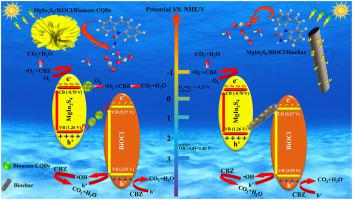Chemosphere ( IF 8.8 ) Pub Date : 2021-09-07 , DOI: 10.1016/j.chemosphere.2021.132192 Kemin Qi 1 , Mengxi Song 1 , Xiaoyun Xie 1 , Yuan Wen 1 , Zirun Wang 1 , Bin Wei 1 , Zhaowei Wang 1

|
The application of environmental-friendly and sustainable green materials in constructing photocatalysts to degrade pharmaceuticals and personal care products (PPCPs) attracts more attention. Herein, biochar (BC) or biomass carbon quantum dots (CQDs) were used to modify MgIn2S4/BiOCl (MB) heterojunction photocatalyst with Z-scheme structure, and improved the photocatalytic degradation performance for carbamazepine (CBZ) in the aqueous solution. Both BC and CQDs could form electron transfer interface with MB heterojunction, resulting in the photodegradation rate of MgIn2S4/BiOCl/CQDs (MBC, 96.43%) and MgIn2S4/BiOCl/BC (MBB, 88.09%) to CBZ within 120 min visible-light irradiation, which were significantly higher than that of MB (65.84%). Moreover, photoelectrochemical and photoluminescence tests verified that CQDs could act as a bridge for storing and transferring electrons in the entire Z-scheme system. Thence, compared with MBB, MBC could produce more •OH and •O2− under the visible light, which was indicated by the results of radical quenching experiments and electron paramagnetic resonance. Interestingly, under the natural sunlight, the photocatalytic performance of MBC to CBZ was even better than under laboratory conditions. In addition, the TOC removal efficiencies of MBB and MBC could reach 85.09% and 93.79% respectively, and ECOSAR program was utilized to further evaluate the eco-toxicity of CBZ and the intermediates towards fish, daphnid, and green algae, indicating that the photocatalytic process involving MBB and MBC showed outstanding toxicity reduction performance. Finally, compared with other composites, MBB and MBC showed higher photocatalytic performance and lower energy consumption, which would provide a green strategy for biochar materials in the photocatalytic treatment of PPCPs in water.
中文翻译:

来自芦苇的 CQDs/biochar 改性 Z-scheme MgIn2S4/BiOCl 具有增强的可见光光催化性能在水中降解卡马西平
环境友好和可持续的绿色材料在构建光催化剂以降解药物和个人护理产品(PPCPs)中的应用引起了更多关注。在此,生物炭(BC)或生物质碳量子点(CQDs)被用来修饰具有Z型结构的MgIn 2 S 4 /BiOCl(MB)异质结光催化剂,并提高了水溶液中卡马西平(CBZ)的光催化降解性能. BC 和 CQDs 都可以与 MB 异质结形成电子转移界面,导致 MgIn 2 S 4 /BiOCl/CQDs (MBC, 96.43%) 和 MgIn 2 S 4的光降解率/BiOCl/BC (MBB, 88.09%) 在可见光照射 120 min 内转化为 CBZ,显着高于 MB (65.84%)。此外,光电化学和光致发光测试证实,CQDs 可以作为整个 Z 型系统中存储和传输电子的桥梁。因此,与MBB相比,MBC可以产生更多的•OH和•O 2 -在可见光下,自由基猝灭实验和电子顺磁共振结果表明。有趣的是,在自然阳光下,MBC 对 CBZ 的光催化性能甚至优于实验室条件下。此外,MBB 和 MBC 的 TOC 去除率分别达到 85.09% 和 93.79%,并利用 ECOSAR 程序进一步评估了 CBZ 及其中间体对鱼类、水蚤和绿藻的生态毒性,表明光催化涉及 MBB 和 MBC 的工艺表现出出色的减毒性能。最后,与其他复合材料相比,MBB和MBC表现出更高的光催化性能和更低的能耗,这将为生物炭材料在水中PPCPs的光催化处理提供绿色策略。


























 京公网安备 11010802027423号
京公网安备 11010802027423号